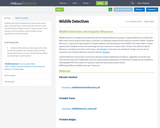
This series of 5 high-quality, standards-aligned, inquiry-based activities have been field-tested by first grade students and families of Wequiock Children's Center for Environmental Science during Safer At Home orders. These activities encourage students to use natural areas around their homes and in their neigbhorhoods as they improve their science observation skils. The materials used are ones generally available at home and the activites require little preparation on the part of caregivers.Created as a part of a WISELearn OER Innovation project, Connect, Explore, and Engage: Using the Environment as the Context for Science Learning was a collaboration of the Wequiock Children's Center for Environmental Science and the Wisconsin Green Schools Network. One of the goals of the project was to create standards-aligned lessons that utilize the outdoor spaces of the school (as well as those of the students' homes). Each section of this resource is an individual activity. While each activity builds on the previous ones, it is possible to use them individually.The observation protocol "I Notice, I Wonder, It Reminds Me Of, I Think Maybe" has been adapted from that of the BEETLES Project.The title image was used with permission and is courtesy of Joe Riederer.
- Subject:
- Earth and Space Science
- Environmental Literacy and Sustainability
- Life Science
- Material Type:
- Unit of Study
- Author:
- Sandy Benton
- Karla Koch
- Date Added:
- 05/28/2020

